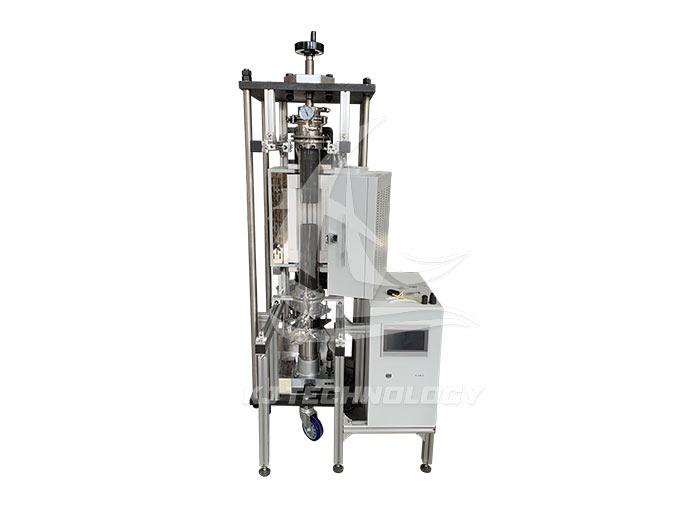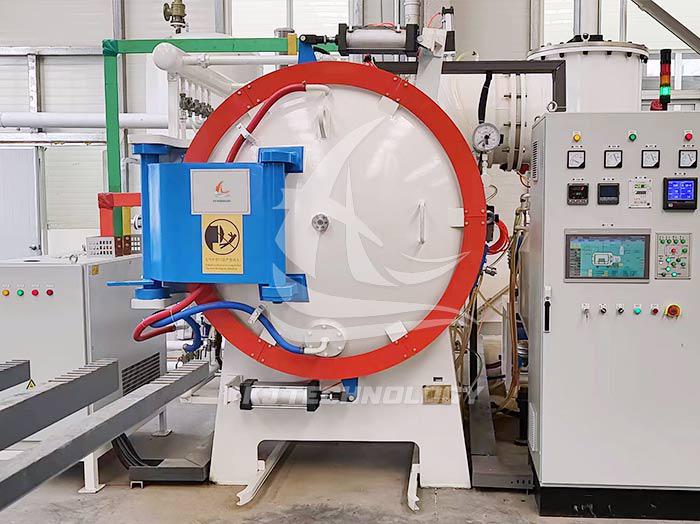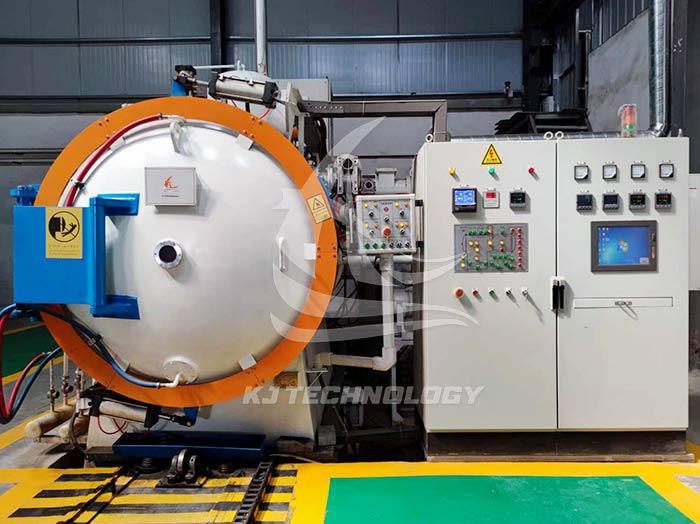Malfunctions and solutions of high vacuum hot pressing furnace during use
 07-18-2025 Author: KJ technology
07-18-2025 Author: KJ technology
High vacuum hot press furnaces may experience process accuracy and equipment lifespan issues during operation due to electrical, vacuum system, mechanical structure, hydraulic/pneumatic system, or control system failures, requiring targeted troubleshooting and repair. The following are common faults and solutions for high vacuum hot pressing furnaces:
1. Electrical malfunction
Abnormal temperature
High temperature alarm:
Check if the temperature controller parameters in the workspace are normal, and refer to other temperature controllers in normal use to calibrate all parameters.
Check whether the output terminal of the solid-state relay in the corresponding working area is broken down according to the circuit diagram. After a power outage, use a multimeter to measure the resistance between the two output points of the solid-state relay. Normally, the resistance should be several megohms or more. If it is broken down, there will be almost no resistance, and a new one of the same model should be used.
When powered on, gently shake the thermocouple probe in the corresponding working area by hand and observe whether the temperature controller displays a large jumping amplitude. If this phenomenon occurs, it indicates that the thermocouple probe has poor contact and needs to be replaced with a new one.
The displayed temperature is too low to reach the set value:
Check if the parameters of the temperature controller in the work area are normal and if there is an output signal.
Check if the thermocouple in the corresponding work area is damaged. Damaged thermocouples can be swapped with thermocouples on normal thermostats and connected to the thermostat to observe the temperature display. If it is confirmed that the thermocouple is damaged, it needs to be replaced.
If there are no issues with the thermostat and thermocouple, it is necessary to test whether the heating tube is working properly when powered on. After powering on, start heating and use a test pen to test the wires (white high-temperature wire at the solid-state output end) connected to the heating tube in the corresponding working area according to the circuit diagram, to see if there is electricity reaching them. If there is electricity arriving, it is necessary to use a clamp meter to measure whether the current is not significantly different from other working areas. If there is no power supply, it is necessary to check the circuit one by one according to the circuit diagram, to see where the power is cut off and whether any components are burned out.
Heating element malfunction
If the temperature rise is insufficient, the first thing to check is whether the power supply is connected properly and whether the heating element is damaged. A multimeter can be used to measure the resistance value of the heating element and determine whether it is open or short circuited. If the heating element is damaged, it needs to be replaced in a timely manner.
The heating element may not respond properly to the temperature control command and remain in a heating state, resulting in excessive temperature. At this point, it is necessary to check the control circuit of the heating element to see if there is any component damage or signal interference, and promptly repair or replace the faulty component.
2. Vacuum system malfunction
Insufficient vacuum degree
Vacuum pump malfunction: Check the operation of the vacuum pump and clean or replace it if necessary. Check if the oil level of the vacuum pump is normal and if the oil quality is clean. If there are any problems, add or replace the vacuum pump oil. Check if the valve of the vacuum pump is tightly closed and if there is any air leakage. If there is any air leakage, repair or replace the valve.
Aging or damage of vacuum seals: Check and replace aging seals, such as furnace doors, observation windows, sealing rings at pipeline connections, etc.
Leakage: Use a vacuum leak detector or other methods to inspect and repair the leakage point. It may be due to a blockage in the vacuum system pipeline, which prevents vacuuming. Check whether there are impurities or foreign objects blocking the pipeline, clean the blockage, and ensure that the pipeline is unobstructed.
Inaccurate display on vacuum gauge: Check the vacuum gauge to ensure its accuracy.
High vacuum cannot be drawn, but there is no air leakage
Aging of high vacuum gauge: Replace the vacuum gauge.
Diffusion pump oil aging: Replace the diffusion pump oil.
3. Mechanical structural failure
The door doesn't close tightly
Check if the hinges of the door are loose, if the buckle is deformed, if the sealing strip at the door is damaged, and if the door panel is deformed. If the above situation occurs, it is necessary to tighten the hinge, repair the buckle, replace the sealing strip or door panel.
The fan has abnormal noise
Check if any foreign objects have entered the impeller of the fan or if the screws securing the motor are loose. If there are foreign objects that need to be cleaned, and if the screws are loose, they need to be tightened.
Pneumatic valve cannot operate
Firstly, check whether the corresponding solenoid valve can work normally and whether the compressed air pressure meets the working requirements. If the air pressure is normal and the solenoid valve is in good condition, it may be that the pneumatic valve itself is damaged and needs to be replaced with a new one.
4. Hydraulic/pneumatic system malfunction
Hydraulic system Failure
Insufficient pressure: It may be caused by hydraulic oil leakage, oil pump failure, or poor cylinder sealing. Firstly, check the hydraulic oil level. If there is a leak, promptly locate the leak point and repair it. Check the working condition of the oil pump and repair or replace it if there are any problems. At the same time, check the sealing components of the oil cylinder to ensure that they are intact and undamaged. If the sealing is poor, replace the sealing components.
Abnormal hydraulic system noise: Clean the oil suction pipeline or oil filter to keep it unobstructed.
Unstable hydraulic system pressure: Clean or inspect the relief valve to ensure there is no dirt or damage.
Air pressure system malfunction
Insufficient gas source pressure: It is necessary to check whether the gas source pressure is sufficient, whether there are leaks in the gas pipeline, and whether the pneumatic cylinder and piston ring are worn and leaking. Timely supplement the air source pressure, repair leakage points, and replace worn piston rings and other components.
5. Control system malfunction
The over temperature alarm light is on and sounding an alarm
Furnace temperature over temperature: Reset the over temperature alarm parameters according to the instructions.
Incorrect instrument settings: Check and correct instrument settings.
Uneven pressure
Pressure head and mold problem: It may be caused by the non parallel contact surface between the pressure head and the mold or improper installation of the mold. Check the flatness and parallelism of the indenter, and grind and repair any uneven indenters. Ensure that the mold is installed correctly and the centerlines of the upper and lower molds are consistent to avoid uneven pressure caused by mold installation deviations.








